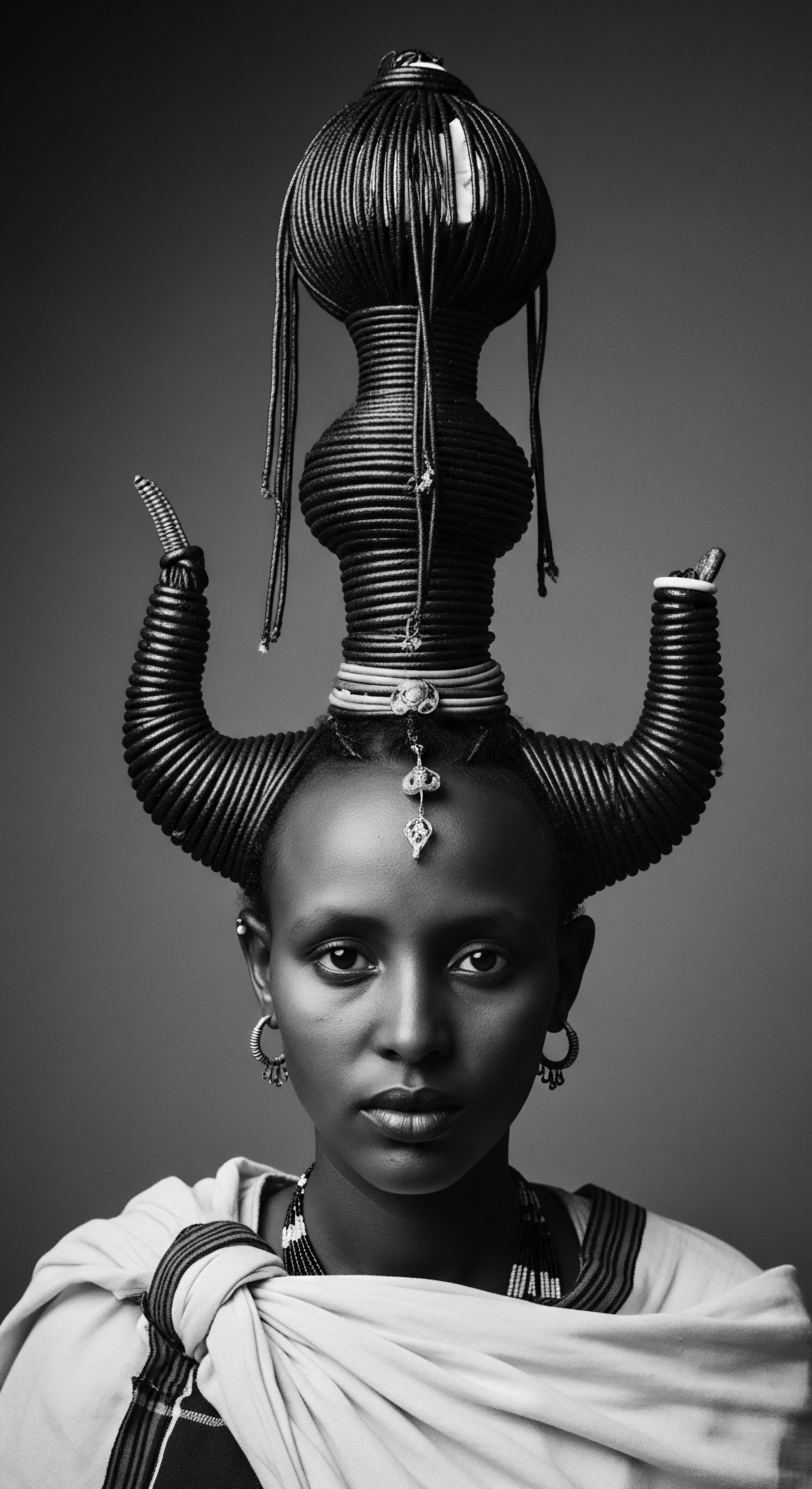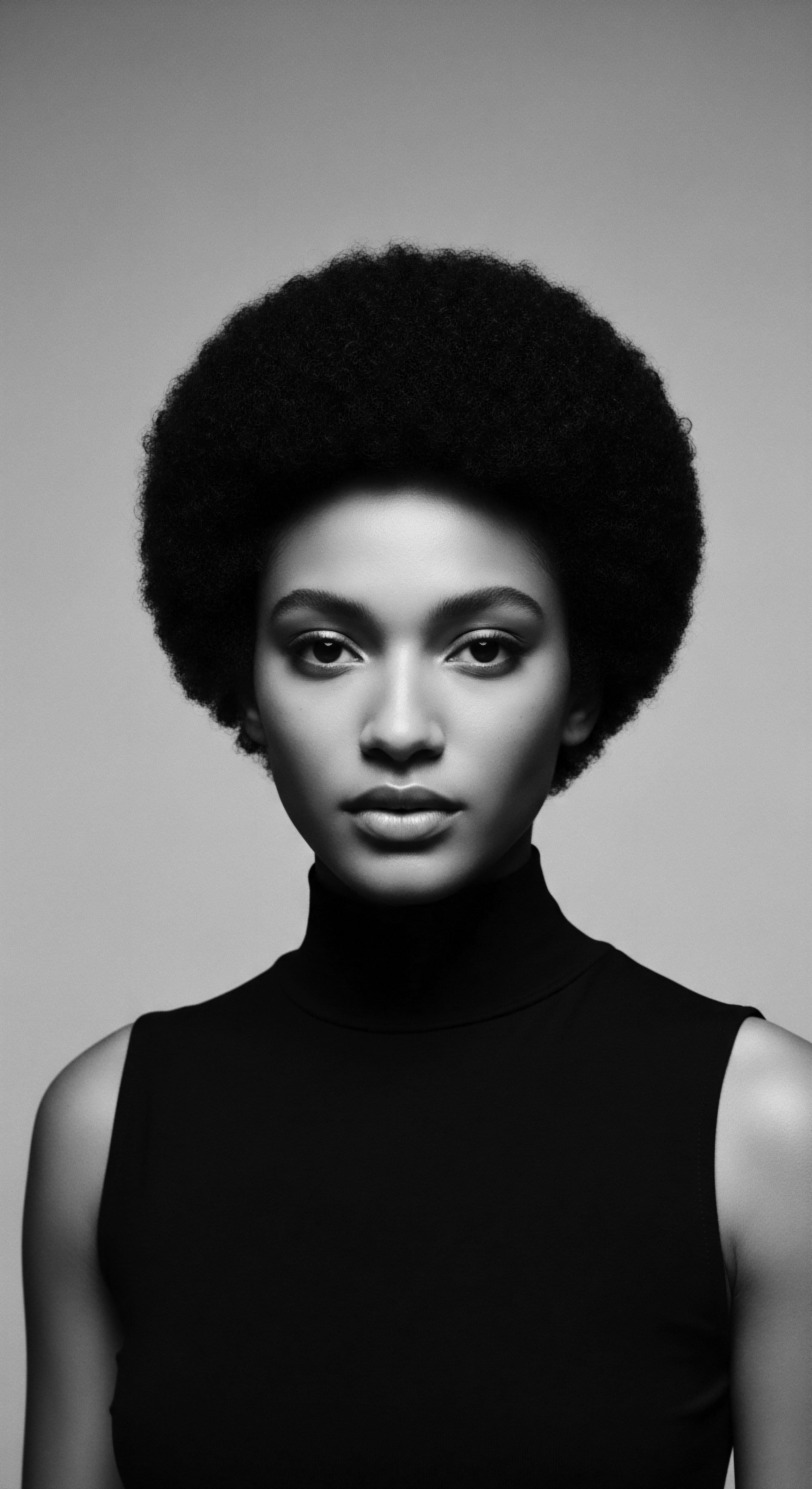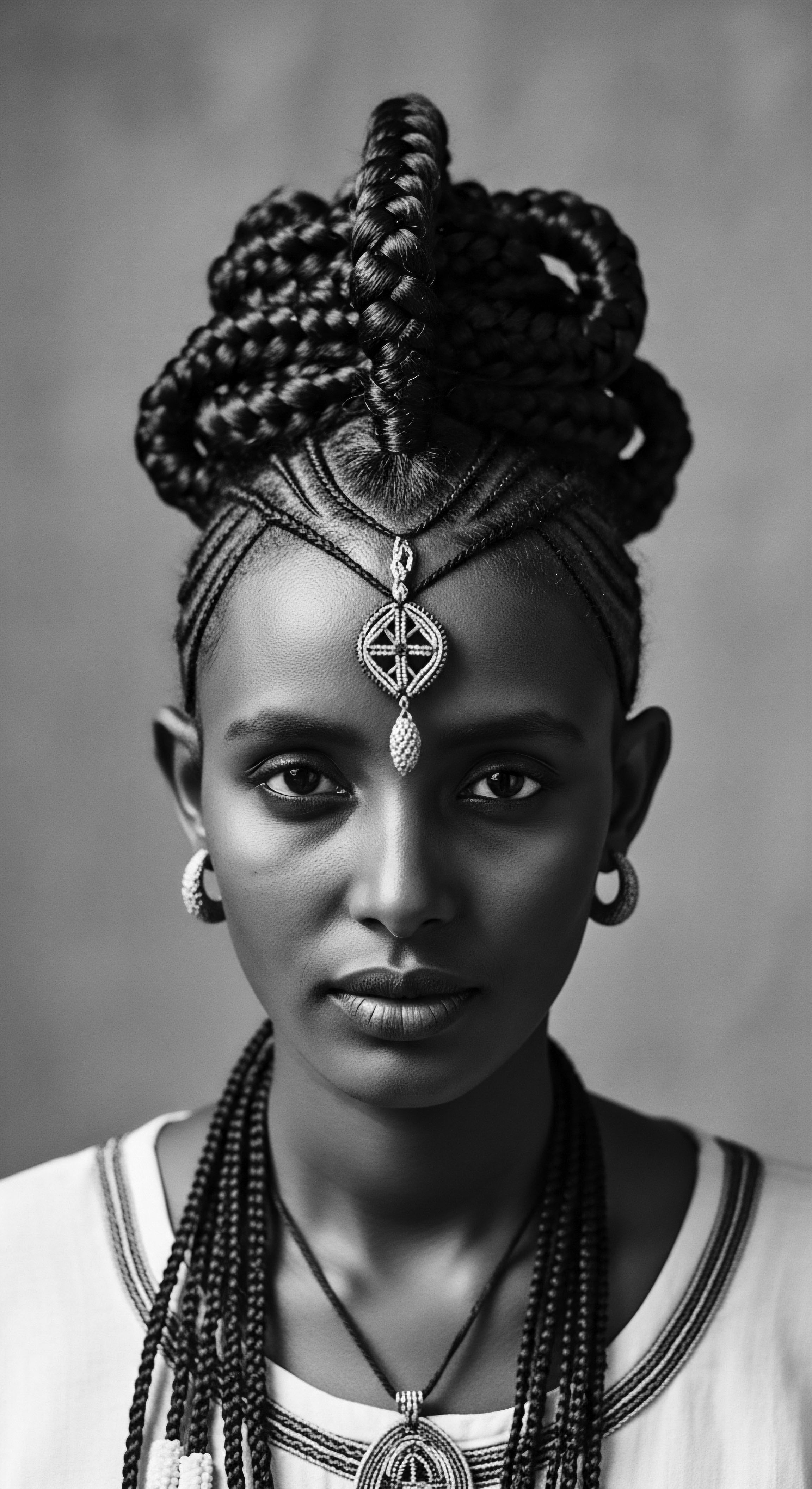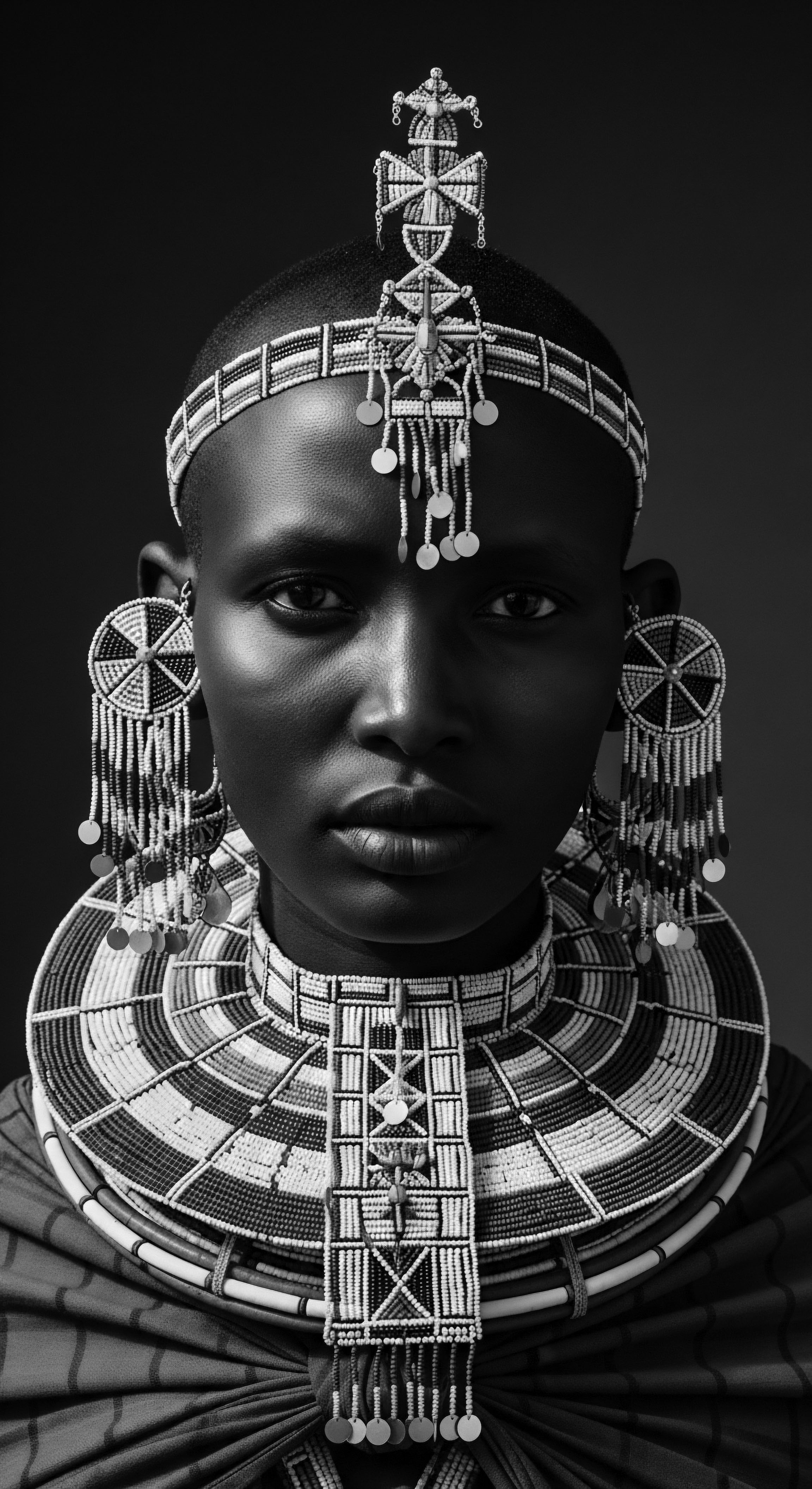
Roots
To walk the path of understanding how textured hair has expressed identity through time is to step into a living archive, a sacred trust passed across generations. This exploration begins at the very source, with the elemental biology that shapes each coil, kink, and curl, acknowledging its profound historical and ancestral significance. For those of us with hair that tells stories in its very structure, this inquiry is not merely academic; it is a homecoming, a recognition of self mirrored in the enduring legacy of our strands. Our hair, a biological marvel, carries within its spiral geometry the echoes of ancient winds and the wisdom of countless ancestors, serving as a powerful, unspoken language that speaks of lineage, community, and the persistent spirit.

Hair Anatomy and Its Ancestral Meanings
The distinct formations of textured hair differentiate it from other hair types, allowing for its remarkable versatility and inherent resilience. These structural distinctions—elliptical cross-sections, varied curl patterns, and fewer cuticle layers—contribute to its unique qualities, including its potential for dryness and its propensity for shrinkage. Historically, across various African societies, an understanding of these characteristics, though not articulated in modern scientific terms, guided the care and styling choices.
Elders possessed an intuitive knowledge of what their hair required, a wisdom honed through generations of observation and practice. This ancestral wisdom often recognized the importance of moisture and protective styling long before scientific studies validated these needs, demonstrating a deep connection to the hair’s natural inclinations.
Textured hair, a biological marvel, serves as a living chronicle of ancestral wisdom and cultural expression, its very structure echoing histories of identity.
The way hair emerges from the scalp, its natural direction, and its inherent coil patterns were not viewed as random. Instead, they were seen as manifestations of a person’s individual spirit and their connection to their heritage. This perspective encouraged a respectful relationship with one’s hair, a bond where care was a dialogue, not a battle against nature. The practices stemming from this understanding ensured that hair health was intrinsically linked to personal and communal wellbeing.

Classifying Hair from a Heritage View
Modern systems categorize hair types by curl pattern, often using numbers and letters. Yet, earlier approaches, particularly within African traditions, approached classification through a lens that honored community, status, and spiritual connection. Hair was identified not just by its curl, but by what it communicated about the individual and their place in the collective.
A particular braid style, for instance, might denote a person’s age or marital status within a community. The patterns could even signal membership in a specific ethnic group, functioning as a nonverbal identifier that transcended spoken language.
Consider the Himba people of Namibia, whose distinctive styles, coated with red ochre paste and butterfat, directly signal stages of life, from youth to readiness for marriage, and express a deep connection to their land and ancestors. This approach to hair as a marker of social standing and belonging, rather than merely a physical attribute, reflects a comprehensive worldview where personal identity is intertwined with community and historical roots.
| Aspect of Classification Primary Function |
| Traditional/Ancestral View Symbol of identity, status, spirituality, community affiliation |
| Modern Scientific View Physical description for care, product selection, or genetic studies |
| Aspect of Classification Key Identifiers |
| Traditional/Ancestral View Hairstyle patterns, adornments, age, marital status, tribal affiliation |
| Modern Scientific View Curl pattern (e.g. 3C, 4A), porosity, density, strand thickness |
| Aspect of Classification Cultural Connection |
| Traditional/Ancestral View Deeply embedded in social hierarchy and ancestral practices |
| Modern Scientific View Primarily for systematic understanding, less direct cultural ties |
| Aspect of Classification The enduring significance of hair in African societies illustrates a rich, communicative tradition that transcends simple aesthetic categorizations. |

What Ancient Lexicons Tell About Textured Hair?
The language used to describe textured hair in ancient societies was steeped in reverence and specificity, reflecting its importance in daily life and ceremonial contexts. Terms for various braid patterns, hair states, and adornments existed, each carrying cultural weight. These words often spoke to the labor involved in styling, the community aspect of hair care, and the symbolic messages conveyed. The lexicon of hair was a living thing, evolving with the traditions it described.
This contrasts sharply with later periods where the language surrounding textured hair became one of derogation, often labeling natural textures as “unruly” or “unprofessional”. Understanding these historical shifts in terminology illuminates the broader societal views imposed upon Black and mixed-race communities.

Hair’s Cycles and Environmental Ties
Hair growth cycles, from anagen to telogen, are biological universals. Yet, the factors influencing these cycles, such as diet, environment, and stress, have long been observed and addressed in ancestral practices. Traditional diets rich in locally sourced nutrients supported hair health, and communal knowledge often included remedies for hair challenges, passed down through oral tradition. Access to natural ingredients like shea butter, coconut oil, and various herbs meant that ancient care practices were often deeply restorative and protective.
The historical context of environmental factors, from arid climates to humid regions, also shaped styling choices, favoring protective styles that shielded hair from harsh conditions and retained moisture. This intergenerational knowledge of local resources and their use in hair care exemplifies a holistic understanding of wellbeing, where hair health was interwoven with the health of the body and the land.

Ritual
From the very structure of the strand, our journey leads us to the hands that shaped it, to the communal gathering, and to the profound acts of styling that have echoed through time. The art and science of textured hair styling is a testament to ingenuity, resilience, and boundless creativity. These practices, whether ancient or contemporary, are far more than mere aesthetic choices; they are living rituals, each twist, braid, or adornment a deliberate expression of self, community, and an enduring heritage.

Protective Styling Through Generations
The ancestral roots of protective styles run deep, extending back millennia to various African communities where necessity and artistic expression converged. Styles such as cornrows, braids, and locs were not simply decorative; they served vital purposes, protecting hair from the elements, minimizing manipulation, and preserving length. Beyond practicality, these styles carried profound cultural significance, acting as visual cues for age, marital status, social rank, or tribal affiliation.
The elaborate nature of some braided styles, often taking hours or even days to complete, fostered strong communal bonds. Braiding sessions became social rituals, spaces for storytelling, shared wisdom, and the strengthening of intergenerational connections.
Consider the use of cornrows during the transatlantic slave trade. Enslaved Africans, stripped of their language and identity, used these tightly woven patterns as a covert means of communication, encoding maps for escape routes and even concealing seeds for survival in their intricate designs. This powerful historical example underscores how a styling practice could transform into a tool of survival and resistance, embodying the deep ingenuity of a people determined to preserve their heritage and freedom.

Natural Styling and Defining Ancient Methods
The methods for defining and celebrating natural texture have deep historical roots. Before the advent of modern products, African communities utilized natural resources to condition, define, and enhance their hair’s inherent curl patterns. Plant-based gels, natural oils, and clays were carefully applied to moisturize strands and give structure to coiled styles. The Yoruba people, for instance, practiced hair threading for length retention, a traditional method that continues to be applied today to achieve smooth, elongated styles without heat.
These techniques often involved communal effort, reflecting a shared understanding of hair care as a collective responsibility and a way to reinforce social ties. The deliberate choice to wear hair in its natural state, adorned with natural materials like beads, cowrie shells, or gold, was a declaration of identity and connection to ancestry.
From ancient survival maps braided into hair to modern celebrations of curl, styling textured hair has always transcended mere aesthetics, serving as a powerful heritage statement.
Such practices were a tangible link to heritage, preserving techniques and knowledge across generations. The focus was on working with the hair’s inherent characteristics, rather than imposing an artificial standard, a philosophical approach that echoes in contemporary natural hair movements.

Wigs, Extensions, and Their Heritage
The use of wigs and hair extensions has a long and rich cultural history, particularly in ancient Egypt, where elaborate wigs made from human hair, wool, or plant fibers were symbols of wealth, status, and religious devotion. These were often intricately braided and adorned with precious materials. Beyond Egypt, throughout various African cultures, the practice of adding extensions to natural hair was common for creating volume, length, or complex sculptural styles that conveyed social information. This historical context challenges the contemporary perception of extensions as solely a modern or purely cosmetic phenomenon, revealing their deep roots in cultural expression and societal signaling.
Even during slavery, despite immense oppression, newly arrived enslaved people continued certain African hair practices, including plaiting and headwraps, as a means of reaffirming their humanity and identity. Headwraps, for instance, became widely adopted across the African diaspora, often carrying symbolic meanings related to status or marital relations, practices that had precedent in West African traditions. The ingenuity of creating hair additions from available materials, or even from donated hair within a community, speaks to the enduring desire to adorn and communicate through hair despite challenging circumstances.

Heat Styling and Historical Reflections
While modern heat styling tools offer new avenues for hair manipulation, traditional methods of altering hair texture often involved gentler, indirect heat or chemical processes derived from natural sources. The early 20th century saw the popularization of tools like the hot comb, which allowed Black women to achieve straightened styles, often as a means of conforming to Eurocentric beauty standards or for societal acceptance. This shift represents a complex period where self-expression sometimes intertwined with pressures of assimilation. Historical accounts suggest that such practices, while offering new stylistic possibilities, could also result in damage to the hair and scalp, leading to a later resurgence of interest in natural, less chemically altered hair.
The current emphasis on a “safety-first” approach with heat styling within textured hair care is a contemporary development, yet it draws an indirect lineage from traditional wisdom that prioritized hair health and preservation. Many ancestral practices inherently minimized harsh interventions, focusing on nourishment and protection to maintain the hair’s vitality.

Tools of Textured Hair Across Time
The complete toolkit for textured hair care and styling has evolved, yet its foundational elements often mirror traditional implements.
- Combs ❉ Hand-carved combs with long teeth and rounded tips, specifically designed to navigate the unique structure of textured hair, were significant cultural artifacts in ancient Africa. These combs often bore symbols and spiritual demarcations, reflecting personal history, group affiliation, and social status.
- Styling Pins and Needles ❉ Used for creating intricate parts, securing braids, and sculpting hair into complex forms, these tools allowed for the detailed artistry characteristic of many traditional African hairstyles.
- Natural Adornments ❉ Beyond functional tools, objects like beads, cowrie shells, feathers, and various metals were essential parts of the hair toolkit, incorporated not just for beauty but also for their symbolic meanings related to wealth, status, or spiritual protection.
- Plant Fibers and Clay ❉ Used for extensions, coloring, or creating matted, sculptural styles, natural materials were integral to ancient hair practices, providing both artistic medium and protective benefits.
These tools represent a continuity of practice, bridging ancient techniques with contemporary approaches, and underscoring the enduring connection between hair care and heritage.

Relay
Our understanding of textured hair, a knowledge passed through centuries, reaches its current form through a continuous relay between ancestral wisdom and the ever-advancing insights of science. This section delves into the deeper implications of how textured hair has expressed identity through time, acknowledging its scientific complexities while centering its profound connections to cultural heritage, Black and mixed-race experiences, and enduring ancestral practices.

Connecting Ancestral Wisdom to Modern Science
The regimens for healthy textured hair today often find their genesis in the ancestral practices of African communities. Science now provides explanations for why certain traditional methods were so effective. For instance, the practice of regularly oiling the scalp and strands, common in many African traditions, aligns with modern scientific understanding of scalp health and the need for emollients to mitigate dryness in hair with its unique structure.
Similarly, protective styles like braids and twists, long employed to minimize breakage and retain length, are now scientifically validated for reducing mechanical stress on the hair fiber. This symbiosis between ancient knowledge and contemporary research deepens our appreciation for the ingenuity of those who came before us.

What Historical Practices Inform Our Routines?
Building personalized textured hair regimens today frequently draws inspiration from centuries of accumulated wisdom. The emphasis on moisturizing, detangling gently, and protecting strands, particularly overnight, carries the echoes of ancestral rituals. In many traditional African societies, hair care was a communal activity, with elders sharing knowledge of indigenous ingredients and techniques.
This collective approach fostered a holistic view of hair health, recognizing its relationship to overall well-being and spiritual balance. For example, traditional recipes for hair oils and conditioners often utilized local plants and butters, selected for their properties in promoting strength and sheen.
The journey of textured hair through time reveals a profound interplay between cultural identity, scientific insight, and the enduring practices that continue to shape personal and communal expressions.
The ritual of hair care served as a conduit for intergenerational bonding and cultural instruction. A mother braiding her daughter’s hair transmitted not only a skill but also stories, values, and a sense of belonging. This historical continuity underscores that a hair regimen is not simply a list of steps; it is a living practice, a connection to a deep, shared heritage.

The Nighttime Sanctuary and Its Historical Basis
The nighttime care of textured hair, particularly the use of head coverings like bonnets or wraps, holds a rich historical basis that extends beyond simple convenience. In many traditional African societies, hair coverings were worn for protection from dust, sun, and to preserve intricate hairstyles, reflecting both practicality and cultural norms. These coverings also served as markers of status or marital state in certain contexts. The modern bonnet, designed to reduce friction and maintain moisture, stands as a direct descendant of these older practices, adapting their function to contemporary needs while preserving an ancestral wisdom of hair preservation.
Moreover, the act of wrapping one’s hair before rest can be seen as a continuation of practices that understood hair as a sacred extension of self, deserving of protection and reverence. This daily ritual becomes a quiet acknowledgment of the hair’s enduring legacy and its intrinsic value.

Traditional Ingredients and Their Modern Recognition
The natural ingredients celebrated in modern textured hair care have been cornerstones of ancestral wellness for centuries.
- Shea Butter ❉ Sourced from the African shea tree, this rich butter has been used for millennia for its emollient properties, providing moisture and conditioning for both hair and skin. Its presence in countless traditional hair concoctions highlights an early understanding of its restorative capabilities.
- Coconut Oil ❉ A staple in many tropical regions, including parts of Africa, coconut oil was valued for its ability to penetrate the hair shaft, reducing protein loss and adding luster. Its enduring popularity speaks to its historical efficacy in hair nourishment.
- African Black Soap ❉ Traditionally made from plantain skins, cocoa pods, and shea tree bark, this cleansing agent was used for both hair and body, known for its gentle yet effective purifying action without stripping natural oils.
Contemporary science has often validated the benefits of these and other traditional ingredients, bridging the gap between ancient remedies and modern formulations. This validation strengthens the argument for a return to ingredients that have stood the test of time, revered for their natural benefits and their deep connection to heritage.

How Hair Discrimination Shapes Identity?
The historical journey of textured hair is not without its struggles. During slavery, the forced shaving of hair served as a brutal act of dehumanization, stripping individuals of a significant aspect of their identity and cultural ties. Post-slavery and into the modern era, Eurocentric beauty standards often deemed natural textured hair as “unprofessional” or “unkempt,” leading to pervasive hair discrimination in educational, professional, and social settings. This discrimination has deeply impacted the self-perception and identity of Black and mixed-race individuals, often pressuring them to chemically alter their hair for acceptance.
However, this history of oppression also spurred powerful movements of resistance and reclamation. The Black Power movement in the 1960s and 70s saw the Afro hairstyle become a potent symbol of Black pride, liberation, and a rejection of imposed beauty norms. More recently, the Natural Hair Movement has continued this legacy, encouraging individuals to embrace their natural textures and challenging discriminatory policies. As Ayana D.
Byrd and Lori L. Tharps recount in their work, “Hair Story ❉ Untangling the Roots of Black Hair in America,” hairstyles in 15th-century Africa conveyed a person’s marital status, age, religion, ethnic identity, wealth, and rank within the community. Post-enslavement, hair often became tied to the type of labor performed, with field slaves hiding their hair and house slaves wearing wigs similar to their enslavers (Byrd & Tharps, 2001, p. 3).
This historical account powerfully illuminates how deeply hair is intertwined with identity and social status, and how the denial of natural hair was a tool of systemic oppression. The ongoing legislative efforts, such as the CROWN Act, aim to legally protect the right to wear natural hairstyles, recognizing that hair discrimination is a form of racial discrimination and further affirming the importance of hair in Black identity and heritage.
| Era/Movement Pre-Colonial Africa |
| Identity Expression Through Hair Diverse styles signified social status, tribe, age, marital status, spiritual beliefs |
| Heritage Connection Direct communal and ancestral communication; hair as a living archive of lineage |
| Era/Movement Transatlantic Slave Trade |
| Identity Expression Through Hair Braids used for covert communication (maps, seeds), headwraps for survival and hidden identity |
| Heritage Connection Resistance, preservation of African practices, adaptation in oppression |
| Era/Movement Black Power Movement (1960s-70s) |
| Identity Expression Through Hair Afro as a symbol of pride, political defiance, rejection of Eurocentric standards |
| Heritage Connection Reclamation of Afrocentric aesthetics, cultural self-assertion |
| Era/Movement Natural Hair Movement (2000s-Present) |
| Identity Expression Through Hair Embracing natural texture, challenging discrimination, advocating for hair freedom |
| Heritage Connection Holistic wellness, self-acceptance, continued fight against systemic bias, legislative advocacy |
| Era/Movement Each historical moment reveals textured hair not simply as an adornment, but as a dynamic canvas for personal and collective identity, deeply anchored in enduring heritage. |

Reflection
The journey of textured hair, from the singular coil to the collective crowning glory, is a profound meditation on endurance, creativity, and the unwavering spirit of identity. It is a story told not in static records, but in the living, growing strands that continue to bear witness to triumph, challenge, and the unyielding beauty of heritage. Every twist, every loc, every natural form is a testament to an ancestral legacy, a silent yet resonant declaration of where we come from and who we are. Our hair is more than keratin and pigment; it is a repository of shared experiences, a vessel of memory, and a beacon for the future.
The whispers of ancient braiding songs mingle with the hum of contemporary dryers, reminding us that care for textured hair is a continuous conversation with our past, a vibrant affirmation in the present, and a powerful statement for generations yet to come. This understanding, that the soul of a strand connects us across time and space, invites a reverence for every hair journey, recognizing each one as a unique, irreplaceable chapter in a grand, ongoing cultural archive.

References
- Byrd, A. & Tharps, L. (2001). Hair Story ❉ Untangling the Roots of Black Hair in America. St. Martin’s Press.
- Dabiri, E. (2019). Twisted ❉ The Tangled History of Black Hair Culture. Harper Perennial.
- Essel, S. (2023). African Hairstyles, Traditional African. The SAGE Encyclopedia of African Cultural Heritage in North America.
- Jacobs-Huey, L. (2006). From the Kitchen to the Parlor ❉ Language and Becoming in African American Women’s Hair Care. Oxford University Press.
- Mercer, K. (1994). Welcome to the Jungle ❉ New Positions in Black Cultural Studies. Routledge.
- Rooks, N. (1996). Hair Raising ❉ Beauty, Culture, and African American Women. Rutgers University Press.
- Thompson, A. (2009). The Hair Story ❉ An Exploration of the Relationship Between Black Women and Their Hair. Journal of Black Studies, 40(4), 831-847.
- White, L. (2000). Speaking with Vampires ❉ Rumor and History in Colonial Africa. University of California Press.
